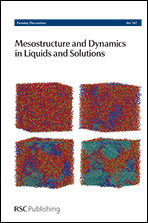Second-harmonic scattering in aqueous urea solutions: evidence for solute clusters?†
Abstract
Measurements of second-harmonic scattering (SHS) from concentrated aqueous solutions of urea are reported for the first time using scanning microscopy. SHS signal was measured as a function of solution concentration (C) over a range of saturation conditions from undersaturated (S = 0.15) to supersaturated (S = 1.86), where S = C/Csat and Csat is the saturation concentration. The results show a non-linear increase in SHS signal against concentration, with local maxima near S = 0.95 and 1.75 suggesting a change in solution structure near these points. Rayleigh scattering images indicate the presence of particles in nearly saturated (S = 0.95) urea solutions. Time-dependent SHS measurements indicate that signals originate from individual events encountered during scanning of the focal volume through the solution, consistent with second harmonic generation (SHG) from particles. SHG from aqueous dispersions of barium titanate (BaTiO3) nanoparticles with diameters <200 nm, showed signals ∼20 times larger than urea solutions. The results suggest the existence of a population of semi-ordered clusters of urea that changes with solution concentration.
- This article is part of the themed collection: Mesostructure and Dynamics in Liquids and Solutions

 Please wait while we load your content...
Please wait while we load your content...